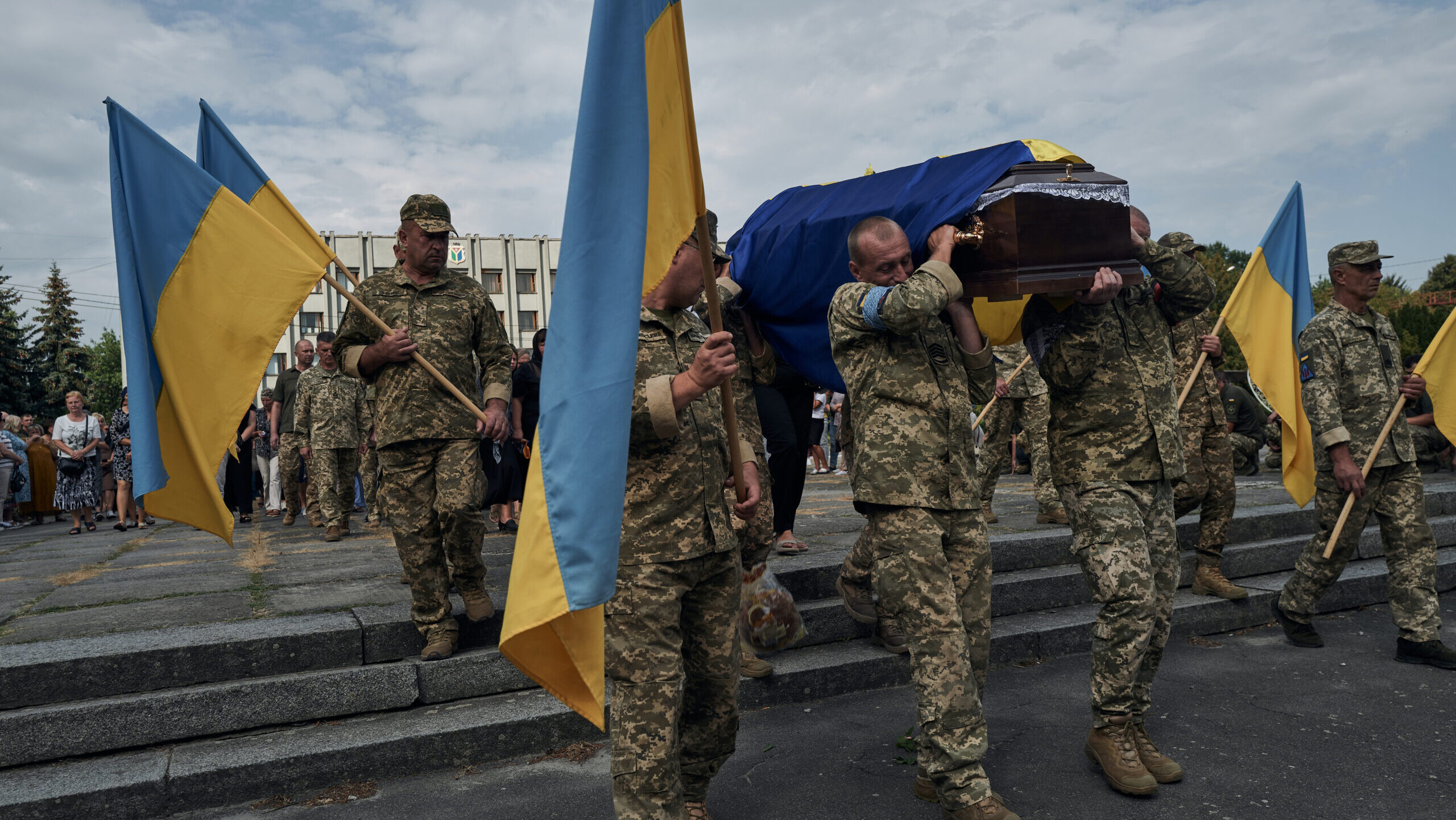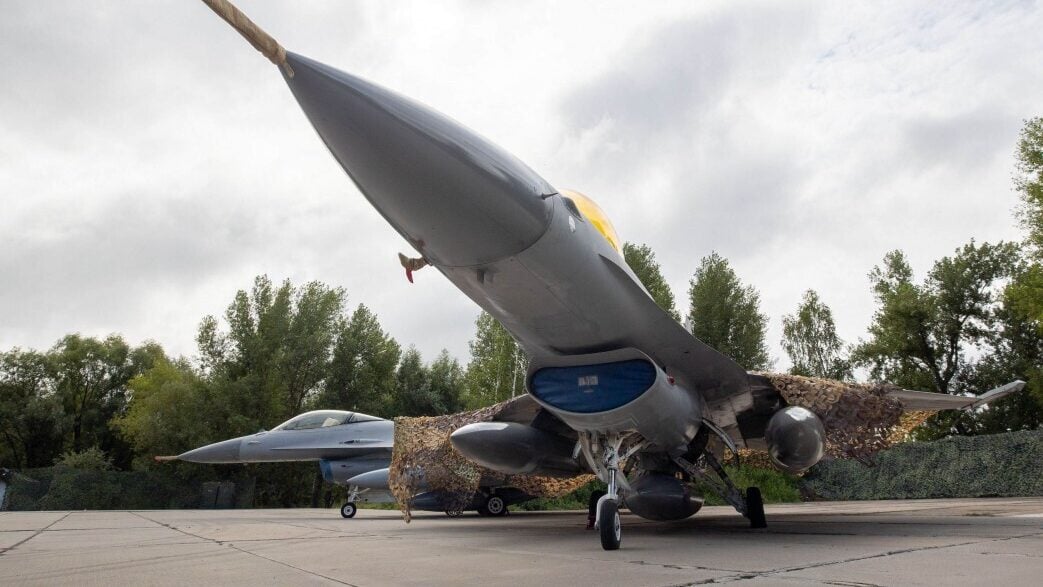
FT. LAUDERDALE, Fla. — When Ukraine’s first F-16s finally arrived in country at the start of August, it was cause for much celebration by Kyiv’s supporters. And so the loss of one of those F-16s just weeks later hit especially hard, and immediately launched questions about what went wrong.
Some questioned whether the pilots were rushed through training. Others wondered if the crash showed that the F-16 wasn’t even fit for Ukraine’s mission. Meanwhile, the families and friends of Col. Oleksiy “Moonfish” Mes, the jet’s pilot who had travelled to the US previously to meet with members of Congress and encourage them to send F-16s to Kyiv’s defense, were left to mourn the loss.
Information has been locked down about the incident, given its high-profile nature for the Zelneskyy government. The loss of an F-16 so soon after having received them means the issue is “doubly sensitive, if not more so, and no one is talking officially,” according to one high-ranking defense industry executive.
But some details of the incident have come out, and sources have helped fill in some gaps for Breaking Defense, including around the theory that the loss was the result of shrapnel that hit the plane.
With it comes a picture of an incredibly dangerous mission where the loss of jets may have been more a question of when, not if — a deadly reality that, Ukrainian experts say, is being exacerbated by the patchwork of capabilities Kyiv has been forced to use in its defense.
A Deadly Mission Set
First, some context. Moonfish’s mission, according to several sources and public reports, was to operate alongside other F-16s, in conjunction with US-made Patriot and other air defense batteries on the ground. The assignment was to take down missiles and drones being fired by the Russians against targets in Ukraine.
It’s important to understand how complex that operating environment is. In Aug. 2022, Breaking Defense talked with several pilots and officers from the Ukrainian air force (PSU) who explained how the fleet of aging MiGs and Sukhois have been performing the air defense mission.
They recalled successfully shooting down incoming Russian cruise missiles with the Russian-designed, semi-active air-to-air missiles originally designed to be fired from these aircraft. But, they said, the mission was by its nature a hazardous one.
“You have a split-second, if that much time, to decide to lock on and fire one of the air-to-air weapons against these incoming missiles,” said one of the pilots. “They are coming at high speeds, and they have to be intercepted before they have passed you. Catching them in a tail chase is not possible in many cases.”
In these same meetings the PSU discussed how they specifically needed the F-16 for this mission. The American-made jet comes with more agile flight controls, better radars and fire-and-forget weapons that would in theory be more effective against the Kh-32 and other long-range cruise missiles being launched against targets in Ukraine.
On the night that Moonfish was lost, he and his squadron were apparently engaged in precisely this kind of operation. According to a statement by the Ukraine General Staff “during the aerial battle, the F-16 aircraft demonstrated their high efficiency, four enemy cruise missiles were shot down by airborne weapons.”
What happened next, according to the statement, was “during the approach to the next target, contact with one of the aircraft was lost. As it turned out later, the plane crashed, the pilot died.”

Integration Challenge
However, the jets are only part of the complex operational sphere.
Ukrainian defense industry specialists, who are closely intertwined with the military and support both the air defense units and F-16s, told Breaking Defense that these missile intercept missions involving fighter aircraft and air defense batteries operating jointly require precision coordination.
Complicating this coordination, multiple sources said, is the fact that neither the PSU fighters nor the air defense units on the ground are using IFF in these engagements. In the beginning of the war, confusion about IFF with both the Russian and Ukraine sides operating some of the same aircraft presented concerns about mistaking one side’s aircraft for another. This practice of not utilizing IFF has been continued with the F-16s now in service. (The MoD and PSU did not return requests for comment on the use of IFF by press time.)
This caused several industry and military sources — and even a member of the Ukraine parliament — to claim the F-16 was a victim of friendly fire. A PSU representative, speaking to multiple outlets, later stated, “different versions [of the crash] are being considered, including the ‘friendly fire’ of their air defence systems, a technical malfunction and pilot error.” (That doesn’t rule out friendly fire, but stops well short of confirming it; a final answer is likely to only come out following a thorough review.)
One scenario floating among the Ukrainian defense community is that the F-16 flew inadvertently through a cloud of debris created by the successful intercept and destruction of one of the incoming Russian missiles. These fragments of the destroyed missile may have caused damage to the engine and other parts of the aircraft, causing the F-16 to break apart and/or the death of the pilot before he could eject.
This version is emerging as one of the more plausible scenarios, due to past precedence, as one of the same industry executives told Breaking Defense that “earlier in the war we lost four other fighters to this same cause of airborne foreign objects disabling the aircraft.”
“There were two MiG-29s and two Sukhoi models lost in this way,” he continued. “It is very possible that this F-16 now makes it aircraft No. 5. The previous losses did not generate this kind of attention because they were not expensive, modern fighters in the class of the American jet.”
Normally, Ukraine gives clear descriptions of what caused jets to be lost, but there are a handful of incidents where the descriptor given is vague and fit what the industry executive described, including the loss of Mig-29s on March 13, 2022 and Oct. 12, 2022, a Su-24 on May 19, 2022, and two Su-27s on June 5, 2022 and March 28, 2023, respectively. Neither the PSU or MOD responded to a request for comment on this claim.
The only way to ensure that a similar tragedy does not occur again, said one military officer, “is to provide us with the additional air defence assets we have been asking to be given for more than two years.
“Until the ground-based air defence network is extensive and redundant enough on its own we will have to keep using fighter jets to protect our cities, our people, our power plants, our hospitals, etc. from Russian missile strikes. It is a dangerous mission, and I fear more aircraft will be lost in this same tragic manner.”

The Training Factor
Supporters of Kyiv have complained about how long the US has taken to train Ukrainian pilots, while the US has in turn emphasized the dangers of rushing pilot training. Moonfish’s death immediately reignited that back and forth, despite the ongoing lack of clarity on what happened in the air that day.
Certainly, there are numerous differences in its overall design of the F-16 compared to the Mikoyan MiG-29s and Sukhoi Su-27s that have been the mainstay of the PSU fighter force. These represent “challenging hurdles that have to be overcome in the course of a training regime,” said a NATO member-nation test pilot who spoke to Breaking Defense in response to the event.
Some of the more significant among these are:
- The Russian-designed, Soviet-era MiGs and Sukhoi aircraft utilize previous-generation, hydromechanical flight control systems (FCS) with a center-stick cockpit. Therefore, the pilot literally can “feel” the stick loads of the aircraft manoeuvring as he moves the controls. That manner of haptic feedback does not exist on the same level – if at all – with the F-16, as it is equipped with a fly-by-wire computer-controlled FCS connected to a side-stick controller. It requires a different and almost delicate style of piloting technique from the control authority of the older Russian models.
- The F-16’s pilot vehicle interface (PVI), particularly the newer models, is characterised by multi-function displays (MFD) and other digital instrumentation associated with “glass” cockpits. The PSU MiG-29s and Su-27s and the Russian-design aircraft subsequently donated by other former Soviet bloc nations have cockpits modernised to differing standards, but still have their fair share of “steam gauge” instrumentation.
- Both aircraft are fitted with mechanically-steered array (MSA) radar sets, but the US radars have far fewer problems with false targets and reliability, compared to the MiG-29’s N019 and the Su-27’s N001 models. Additionally, the F-16s can fire active radar-homing, fire-and-forget air-to-air missile, the AIM-120 AMRAAM, but the PSU Russian-made aircraft are not equipped with the Russian analogue, the R-77/RVV-AE. Modifications have been made to the PSU aircraft to allow them to use the US air-launched weapons, but it is less than a perfect match-up.
Despite these difficulties, however, the record to date was that the Ukrainian pilots had acquitted themselves well in learning to operate the F-16, and despite regular sorties in the month since Moonfish’s death, there have been no reports of pilot difficulties. An unnamed source who spoke to CNN and other media stated, “the Ukraine Armed Forces do not believe pilot error was behind the incident.”
The lack of experience with the F-16 could certainly have contributed in a situation where the pilot, unused to the intricacies of flying the American-jet, was unable to react as he would have with another jet. But the reality is the answers may never be found as to what role, if any, the speed of training had on the mission’s deadly outcome.
Speaking this week at the annual Air and Space Forces Association conference outside Washington, Gen. James Hecker, the head of US Air Forces in Europe, said that “As far as the aircraft accident with the F-16 and unfortunately losing a pilot, there’s an ongoing investigation that Ukraine is conducting. We’ve offered our help in that investigation. We’ll see if they take us up on that offer.
“But anything that comes out of that, and any preliminary things that we’re taking a look at to develop into training, both in Denmark as well as the US, to see if there’s any changes that we need to make to the training to make sure that this doesn’t happen again.”

The Big Takeaway
If there has to be a top-level “lesson learned” from this loss, it may be that integrating a new platform into a military that is engaged in a high-intensity conflict needs to be understood as a gradual process.
There are specific examples in the past of post-Soviet militaries operating both western and Russian-designed fighter aircraft, but where they differ from the Ukrainian approach is that those air forces tend to employ those new aircraft in complementary, but distinctly different, missions. Most new F-16 users would not want to immediately put the aircraft into a role that has been filled for more than two years by the MiG-29 and Sukhoi models, as the PSU did when it put the F-16 aircraft into a missile-hunting assignment.
More broadly, the situation also serves as a reminder that the F-16s are not a cure-all for the ongoing conflict. But this downing also doesn’t mean the F-16 is a failure.
Speaking at an event in July, Hecker stated that it would be unrealistic to expect the F-16s to have an immediate and dramatic impact in the air power dimension of the war.
“It’s not going to be the … golden bullet, that all of a sudden, they have F-16s, and now they’re going to go out and gain air superiority,” he said. What will make a difference in the long run, he explained, is the ability to more effectively employ US air-launched weapons.
Up to now the PSU has been “dropping them off MiG-29s and Su-24s. Now they’re going to have the opportunity to actually drop them off of an airplane that they were designed to come off of, which will give them more capability to change the targets in flight and things like that.”

